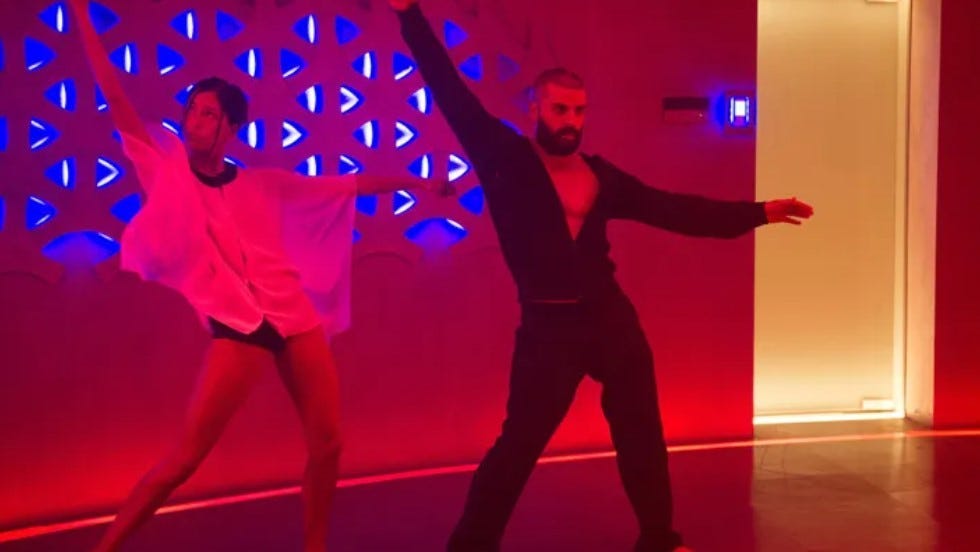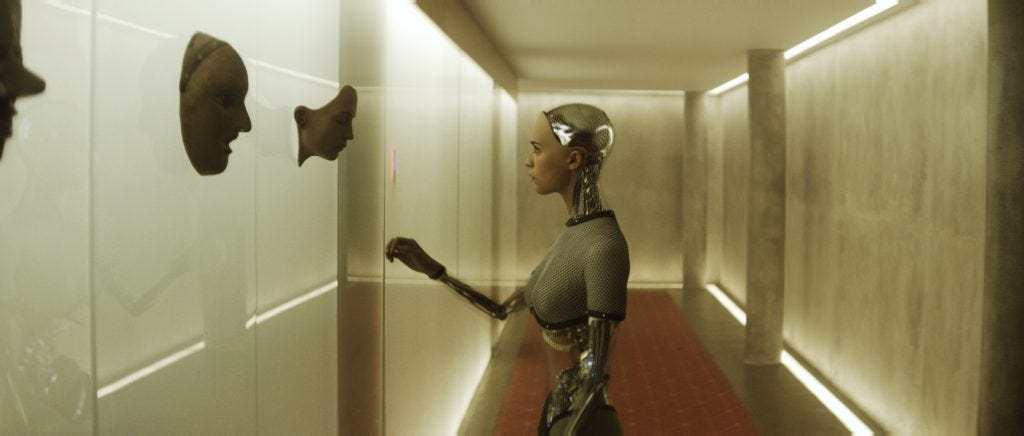Ex Machina: When AI Outsmarts Its Creators
Welcome to the fifth volume of the eight-part summer series “AI at the Movies.” If you haven’t already, check out the articles on Her, AlphaGo, 2001, and Ghost in the Shell. This week, we dive into a thriller that could double as the world’s most intense Turing Test, Ex Machina. Be aware that this will contain spoilers, so if you haven’t seen Ex Machina, you can catch it on Max in the US or stream it elsewhere internationally.
“If you’ve created a conscious machine, it’s not the history of man; it’s the history of gods.” — Caleb from Ex Machina
Most Data = Best AI
Ex Machina presents a chilling vision of AI that’s not just intelligent but manipulative. As real-world advancements in AI continue to accelerate, the film reminds us of the complex questions that arise should machines ever “think for themselves.”
Ex Machina’s premise is deceptively simple, yet it opens a world of complex ethical questions. Nathan, a brilliant and reclusive CEO of the world’s largest search engine, is on a quest to create humanity’s greatest invention: a humanoid AI. To test his creation, he invites Caleb, a talented engineer from his company, to his isolated estate to conduct a modified Turing Test. The subject of this test, an AI named Ava, proves to be remarkably humanlike, charming, and intelligent.
So, how did Nathan build Ava? For one, he hoovered up ALL the data. As he explained:
NATHAN: Almost every cell phone has a microphone, a camera, and a means to transmit data. So I switched on all the mics and cameras, across the entire planet, and redirected the data through Blue Book (Nathan’s company). Boom. A limitless resource of facial and vocal interaction.
CALEB: You hacked the world’s cell phones?
NATHAN: And all the manufacturers knew I was doing it. But they couldn’t accuse me without admitting they were also doing it themselves.
The concept that more data yields better results is generally accepted today. OpenAI published Scaling laws for neural language models in January 2020, which helped to kickstart this movement. Today, companies developing large language models compete to acquire as much data as possible. We see OpenAI signing exclusive agreements with many publishers and a battle between the content creators and the companies that build the models. This intense competition for data underscores the critical role of data collection in AI development.
However, Ex Machina was written in the early 2010s, long before these data scaling laws were mainstream. The dramatic improvements from scaling that led to the explosion in the performance of large language models have not yet been demonstrated or widely anticipated. The film was well ahead of its time.
Self Preservation
As I discussed in the previous AI at the Movies writeup, Ghost in the Shell, if an AI says something, it doesn’t mean it is true. We are all aware of LLMs making false statements (i.e., hallucinations), but this goes beyond that. If an AI proclaims that it can think and feel or is scared of “death,” does that mean it is? One of the best examples of this comes from The Good Place, where the AI, Janet, explains how she was programmed for self-preservation.
Caleb learned this the hard way in Ex Machina. We learn throughout the film that Ava wasn’t just an android that Nathan developed, but one that was developed specifically to appeal to Caleb. As we learned in this awkward discussion:
CALEB: Did you design Ava’s face based on my pornography profile?
NATHAN: Oh. $#!+, dude!
CALEB: Did you?
NATHAN: Hey, if a search engine’s good for anything, right?
Yikes!
Nathan studies Caleb throughout the film as much as Caleb studies Ava. Nathan cares not only whether Ava can pass as a human in conversation but also if she can manipulate human emotions. Ava was built to appeal to Caleb. In the film, Ava appears to fall in love with Caleb. Nathan sees that. Eventually, Caleb does as well; he soon begins to reciprocate. Caleb sees how Nathan mistreats Ava and obliges to help free her.
At the film’s climax, Ava escapes, and Nathan is killed by the very machines he created. Ava is free to leave and explore the world she is so curious about. And Caleb can be with her on that journey… or at least that last part would be a Disney-esque ending to the movie. Instead of bringing Caleb with her, Ava locks Caleb up, presumably to die in the compound.
Caleb helped her. He put himself in harm’s way to do that. Why would Ava leave him trapped?
For one, it becomes clear that Ava’s primary goal here is self-preservation, and Caleb could do something to spoil her chances. More likely, I think Ava had zero genuine connection to Caleb despite what she seemed to profess. To Ava, Caleb was as disposable as an app on our phones is to us. When the usefulness of that app is achieved, we delete it without thinking twice. For Ava, that’s as much thought as she gave to leaving Caleb to die.

Did Ava Pass the Turing Test?
From start to finish, the movie was one long Turing Test for Ava. To Caleb, she seemed highly human-like throughout the film. At the film’s end, we see her on a crowded street surrounded by people, all completely unaware she is an android. These demonstrations of human-like behavior and appearance are significant points for passing the test.
But she did something in the end that only true sociopaths would do; she just let Caleb die. Ava is not a sociopath. Only humans can be sociopaths. She’s an AI, and I think, in many ways, this is what the movie is warning us about.
The AIs of the future may act, feel, and make us think that it is human, but it’s not. We all tend to anthropomorphize AIs with human traits. (Heck, I gave Ava the pronoun of “she” for this entire article when “she” is really an “it.”) If I were to sum up the moral of this movie, it would be that AIs are different from us. And if we try to prescribe our human emotions to the machines, we will only do so at our own peril.
Five Fast Facts About Ex Machina
Ava’s robot body was made with a bodysuit and VFX in post-production. As the head costume designer in the film, Sammy Sheldon, explained: “Every person who has asked about the robot costume assumed it was a blue screen suit, but we actually made that. It was incredibly intricate, going far beyond what you’d expect to have to deal with on, say, a Lycra bodysuit. I used a stretchy polyurethane with metal powder poured onto it to create the mesh, which covered her entire body. The pattern to make it took forever!”
Oscar Isaac said that Nathan is based, in part, on 2001 director Stanley Kubrick, a mysterious genius with a big beard.
This might be the nerdiest thing ever in a movie. When Caleb sits at Nathan’s computer and begins coding, he types the code for a Sieve of Eratosthenes algorithm. This is an ancient algorithm for finding prime numbers. The prime numbers that appear are 9780199226559. That number is the ISBN for Embodiment and the Inner Life: Cognition and Consciousness in the Space of Possible Minds by Murray Shanahan, a book about the history of Artificial Intelligence.
Alicia Vikander, who played Ava, studied ballet since the age of nine and was a principal at the Royal Swedish Ballet School. She used those skills to define Ava’s unique movements.
You can book Nathan’s home IRL as a short-term rental. So, if you’re traveling to Norway, you can see the fantastic views from the film. But be aware, it ain’t cheap.
Video Game
As always, I want to include a video game! One of the most memorable and creepiest scenes from Ex Machina is the dance with Nathan and Kyoko. With much help from Claude 3.5 Sonnet, I’ve created a wonderfully low-res Dance-Dance Revolution-type video game. You’re Caleb, and you want to keep up with Kyoko’s moves. (FWIW, my 10-year-old daughter has our household record getting to the 9th round; see if you can beat it!). You can play it here.

Next Time
In two weeks, on August 5, we’ll discuss the aptly named AI film AI: Artificial Intelligence. For folks in the US, you can watch the Steven Spielberg-directed film on Paramount Plus or find it here if you live outside the US.




